
A well-known reservoir in Anuradhapura is Basawakkulama Reservoir, also known as Abhayavapiya. Both domestic and international visitors to Anuradhapura seldom fail to visit the lake. Tourists who are looking forward to viewing an amazing sunset over Abhayawapiya Lake could take advantage of this fantastic chance. because it is a stunning sight. Swarnamali Maha Dagoba has brought various hues to the landscape in addition to the Abhayagiri Lake. King Pandukabhaya, who governed the nation from around 377 to 307, constructed it. The Basawakkulama tank is where the ancient Anuradhapura irrigation system's rainwater harvesting process begins.
Abhayawapiya Wewa has a maximum water capacity of 1910 acre-feet. About 174 hectares of water may be stored in the tank. The bund measures 3900 feet in length and 15.5 feet in depth on average. The lake's primary purpose is to offer pilgrims and locals with access to clean water, sanitary amenities, and 450 acres of land for irrigation. Abhayawapiya Lake is infertile even during the monsoon season. The presence of the Biso Kotuwa, Pita Wana (overt flow of water), and Sorowwa (outflow of water) in the Wewa gave the building additional significance.
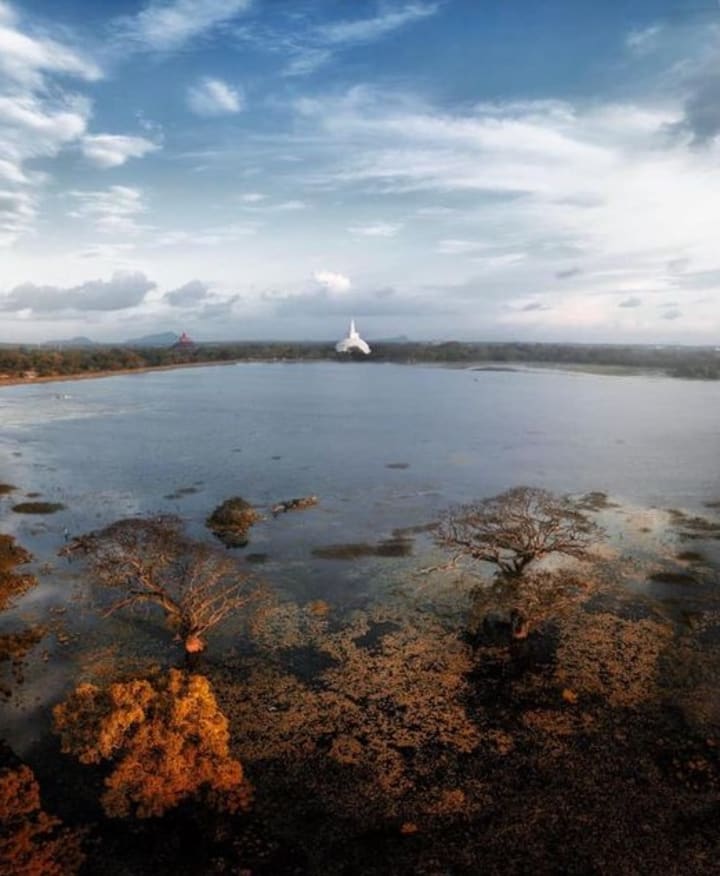
It is regarded as one of Sri Lanka's most proudly old irrigation systems by evidence archaeologists. It is reported that King Pandukabhaya constructed this tank after defeating his uncle in an unending conflict. He was a pioneer in the building of the Anuradhapura Kingdom's capital. For seventy years, he was the monarch. The Sinhalese constructed the tanks across Sri Lanka in accordance with the concept of "Tank, Dagoba, Village, and Temple." In the past, the Sinhalese were skilled in creating canals and artificial reservoirs with sophisticated irrigation systems. During the reigns of King Panudkabhaya, King Parakrmabahu, and King Dathusena, this knowledge was expanded. Gamini Wewa, Jaya Wewa, and Abahya Wewa were all invented by King Pandukabhaya. It should be noted that Sri Lanka's agricultural and irrigation systems owe a lot to the monarchs who have reigned there.
Although Bsawakkulama Weva has irrigation facilities for an additional 916 acres, its primary function is to supply water to residents and pilgrims. Up to five feet tall, it typically still contains water. Millions of pilgrims depend on Basawakkulama Weva to meet their water needs, particularly during the Poson pilgrimage seasons and other times of the year. The fact that the first tank constructed in our nation is still operating and providing excellent service to the people in our country is the strongest proof of the veracity of our proud irrigation civilization. As such, highlighting it as the legacy of a proud nation that enjoys independence to the rest of the globe is a truth.

Anuradhapura ancient city
A portion of the Bhodi tree from the Jaya Sri Maha Bodhi in India, beneath which Lord Buddha obtained enlightenment, was planted in Anuradhapura, in the northern center of Sri Lanka. The oldest known still-living tree is the Sri Maha Bodhiya. The city also includes intriguing to explore palaces, monasteries, and monuments, all of which are in ruins.
Buddhists adore the ancient stupa known as Ruwanwelisaya. The Buddha's collarbone is preserved at Thuparamaya, which is regarded as Sri Lanka's first dagaba (or pagoda). Between the Ruwanvaliseya and Sri Maha Bodhiya stands Lovamahapaya, commonly known as the Brazen Palace. The biggest stupa in Sri Lanka is Jetavanarama. Other stupas and relics may also be seen in the region, towering above the huge expanses of rice fields in addition to these lovely locations.

These famous structures may be seen all around the old city, remainings of a people that prospered under the leadership of their kings and queens in the past. Learning about their way of life while exploring these remains is a tremendous delight. The structures were expertly constructed by carpenters and tastefully decorated by artists.
Anuradhapura is said to have been a major economic center in South Asia and the capital of the Sinhalese from around the 4th century BC to the 11th century AD. The history of Anuradhapura may be traced back to the 4th century BC, but excavations have revealed items from the Iron Age that can be easily dated to 900 BC. The society is thought to have grown and prospered since then to become one of South Asia's most opulent kingdoms.
Places to Visit
- Jaya Sri Maha Bodhi

UNESCO has proposed Anuradhapura as a candidate for World Heritage status. The Jaya Sri Maha Bodhi was the primary factor in Anuradhapura's transformation into a holy city.
According to recorded data, this sacred tree was erected in the ancient Maha Megha Vana Royal Park in Anuradhapura in the month of "Unduvap" (December), 236 BC. On the orders of Arahant Mihindu Maha Thero, Arahant Sanghamitta Maha Theree ceremonially carried the sacred Bodhi sapling here. In the Maha Megha Vana Royal Park, which is devoted to the revered bhikkhus, King Devanampiyatissa of Sri Lanka erected this Bodhi tree with a great ceremony. The Anuradhapura Jaya Sri Maha Bodhi is 2,247 years old at this time.
Read: https://zeloan.blogspot.com/2022/07/jaya-sri-maha-bodhi-in-sri-lanka.html
- Ruwanweli Maha Seya
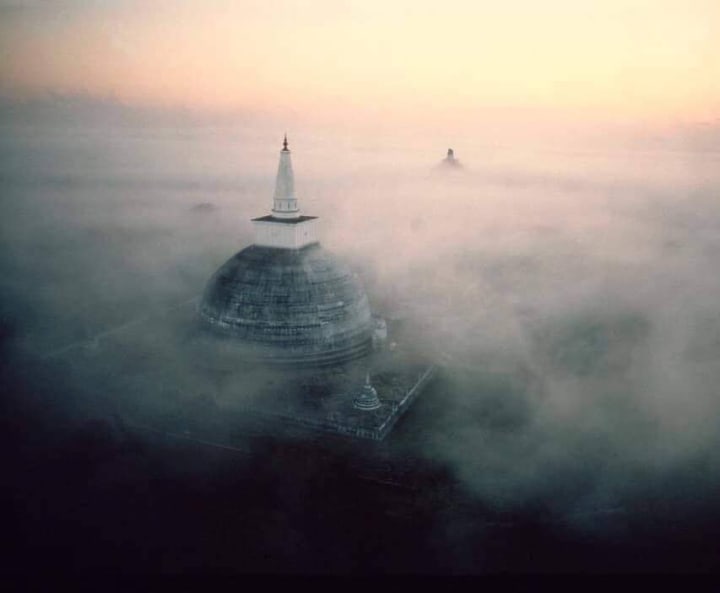
The Ruwanweli Maha Seya, sometimes referred to as the Mahathupa (the Great Thupa), which is a stupa(a hemispherical structure containing relics) in Anuradhapura, Sri Lanka. The stupa has the greatest collection of the Buddha's relics anywhertwo quarts, or one Donaand is where they are kept. Around 140 B.C, Sinhalese Monarch Dutugemunu, who succeeded Chola King Ellalan as king of Sri Lanka following a conflict, constructed it. Other names for it include Swarnamali Seya, Rathnamali Seya, and Svaṇṇamāli Mahaceti (in Pali).
This is one of the 16 sites of worship known as the "Solosmasthana" and the "Atamasthana" (the 8 places of veneration). With a height of 103 meters (338 feet) and a diameter of 290 meters, the stupa is one of the oldest and tallest structures in the world (951 ft). Numerous rulers restored the stupa, which had an initial height of roughly 55 meters (180 feet). After this stupa, the Kaunghmudaw Pagoda in Sagaing, Myanmar was designed. The Mahavamsa provides a thorough description of the stupa's construction and dedication ceremonies.
Read: https://zeloan.blogspot.com/2022/10/ruwanweli-maha-seya-in-sri-lanka.html
- Kandalama
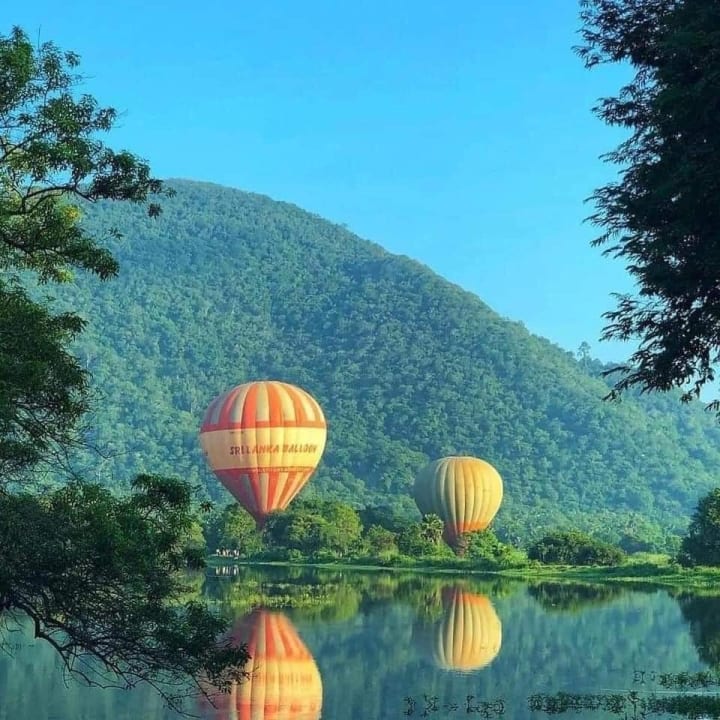
Sri Lankan settlement of Kandalama. It may be found in Central Province. The Dambulla cave temple from the first century BC and the Sigiriya rock fortification from the fifth century AD are the two UNESCO world heritage monuments that stand out for Kandalama.
The 2000-year-old cave temple at Dambulla and the Sigiriya Rock Fortress are both UNESCO World Heritage Sites, and Kandalama is also home to the Kaludiya Pokuna Archeological Forest and one of Sri Lanka's first five-star hotels, Heritance Kandalama.
Read: https://zeloan.blogspot.com/2022/07/kandalama-in-sri-lanka.html
- Sigiriya
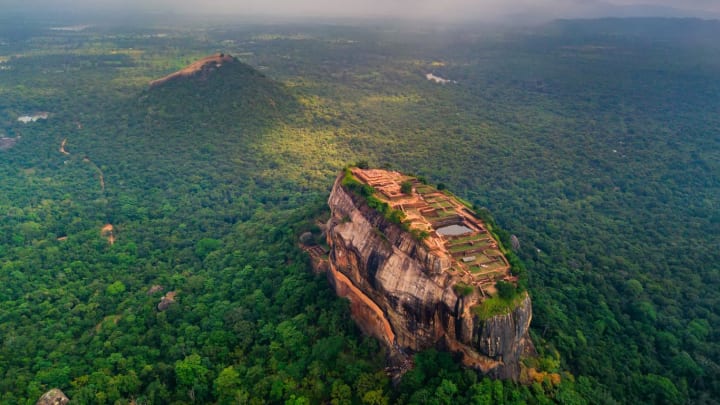
In the northern Matale District of the Central Province of Sri Lanka, close to the town of Dambulla, sits the historic rock fortification known as Sigiriya or Sinhagiri. It is a location with a historical and archaeological value that is dominated by a huge granite column that stands 180 meters (590 feet) tall.
This location was once a vast forest, but due to storms and landslides, it was transformed into a hill, and King Kashyapa (477–495 AD) chose it as the site of his new capital. On top of this rock, he constructed his palace, which he then painted with vibrant frescoes. He constructed a huge lion-shaped doorway on a little plateau approximately halfway up the side of this rock. This building gave this location its name, Sinhagiri, or the Lion Rock (an etymology similar to Sinhapura, the Sanskrit name of Singapore, the Lion City).
Read: https://zeloan.blogspot.com/2022/07/sigiriya.html
- Wilpattu National Park

A national park in Sri Lanka is called Wilpattu National Park (Willu-pattu, "Land of Lakes"). The occurrence of "Willus" (natural lakes), which are rain-fed water basins or depressions with sand rims, makes this park special. The park is situated in Sri Lanka's northwest coast lowland dry zone, 30 kilometers (19 miles) west of Anuradhapura and 26 kilometers (16 miles) north of Puttalam (about 180 kilometers (110 miles) north of Colombo). The park's size is 1,317 km2 (508 sq mi) (131,693 hectares), and its elevation ranges from 0 m to 152 m (0-499 feet). Wilpattu is home to around one hundred and six lakes (Willu) and tanks. The largest and one of the first national parks in Sri Lanka is Wilpattu. The leopard population (Panthera pardus kotiya) in Wilpattu is well-known worldwide. The Wilderness and Wildlife Conservation Trust performed a remote camera study in Wilpattu from July to October 2015; forty-nine individual leopards were photographed there. The core area density of the survey region was between that Horton Plains National Park and Block I of Yala National Park.
Read: https://zeloan.blogspot.com/2022/08/wilpattu-national-park-in-sri-lanka.html
- Isurumuniya Rajamaha Viharaya

The Tisa Wewa is not far from the Isurumuniya Viharaya. It is also recognized for its stone sculptures, the most well-known of which is one called the "Isurumuniya Lovers." The Royal Family, Elephant Pond, and the Horseman are shown in the other sculptures.
It is thought that the Vessagiri Vihara, which is close by, is the true Isurumuniya Vihara. The Temple was formerly known as the Meghagiri Vihara. Devanampiya Tissa ruled the nation from the capital city of Anuradhapura at the time the Isurumuniya Viharaya was built. In order to accommodate the 500 high-caste children who were ordained during his reign, Isurumuniya was constructed as a monastery complex. King Kasyapa then restored it after that (473 – 491 AD).
- Abhayagiri Viharaya
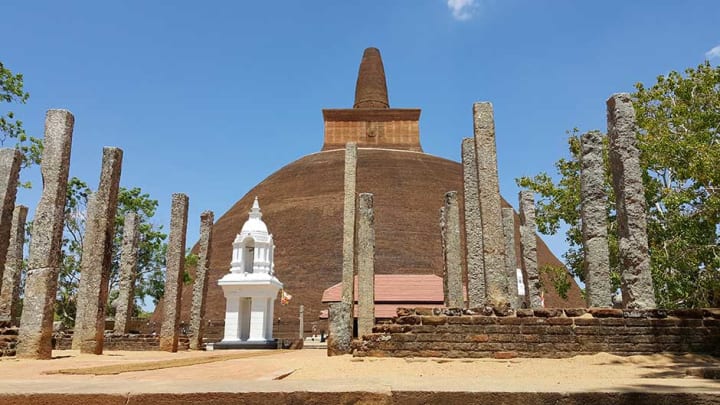
Visit the Abhayagiri Monastery, one of the holiest Buddhist pilgrimage destinations. It is a huge, spreading ruin. On exhibit are magnificently carved moonstones from the seventh to eighth centuries, as well as magnificent bathing pools and deftly sculpted balustrades. The British began to learn about Anuradhapura's antiquities and the great legacy of the nation here in the 19th century. Discover the hemispherical stupa of Lankarama Dagoba, the biggest man-made pond in Sri Lanka, Eth-Pokuna, and Pancavasa, also known as the Five Residences, which are the homes of the monks and have a lotus pedestal in the center that suggests a Buddha statue formerly stood there. The Jewel Palace, Ratnaprasada, is the largest structure on the land. It is a collection of ruins that is guarded by two stones that are decorated with flowers, dwarfs, and a pot of abundance.
- Jetavanaramaya

The Jetavanaramaya is a stupa that may be seen among the Jetavana Ruins in the revered Sri Lankan city of Anuradhapura, a World Heritage Site. After the mahavihara was destroyed, Mahasena of Anuradhapura (273–301) began building the stupa. The stupa's construction was finished by his son Maghavanna I. The relic that is kept here is thought to be a piece of a belt or sash that the Buddha fastened.
The stupa, which stands 400 feet (122 meters) tall and is the tallest stupa in recorded history, is significant in the history of the island because it symbolizes the conflicts between the Theravada and Mahayana sects of Buddhism. It is also significant because it is one of the tallest structures in recorded history. With a base area of 233,000 m2, the building is no longer the highest but is still the biggest (2,508,000 sq ft). The engineering expertise underlying the building's construction is a notable development in the island's history; it employed over 93.3 million baked bricks. The stupa, which was erected on the site of the demolished mahavihara and sparked a revolt by a minister of King Mahasena, also symbolizes the sectarian divisions among Buddhist monks.
- Kaudulla National Park

On the island of Sri Lanka, 197 kilometers separate Kaudulla National Park from the capital city of Colombo. On April 1, 2002, it was declared a national park, making it the island's 15th such area. More than 10,000 visitors visited the National Park during the 2004–2005 season, bringing in Rs. 100,000 from admission fees. BirdLife International has designated Kaudulla as an Important Bird Area, together with Minneriya and Girithale. In the past, King Mahasen constructed 16 irrigation tanks, including Kaudulla. After being abandoned for some time, it was rebuilt in 1959. Large animals, fish, and reptiles are just a few of the many plant and animal species that it currently draws and sustains.
- Mihintale

In Sri Lanka, Mihintale is regarded as the birthplace of Buddhism. Legend has it that King Devanampiyatissa was converted to Buddhism by the Indian missionary Mahinda at Mihintale, also known as "Mahinda's Hill," in 247 BC, establishing Buddhism as the island's official religion. Mahinda, the famous Mauryan ruler Asoka's son, was tasked by his father with spreading the Buddha's teachings throughout Sri Lanka. Unlike in India, where it was born, and it would later go into terminal decline, Buddhism was instantly adopted with fervor by the Sinhalese people and quickly became firmly entrenched throughout the island.
Google Map: https://goo.gl/maps/td2SJVAiBYXRdAPq8
About the Creator
Zeloan
I'm a Traveller, Blogger, and Content Creator. Visit Sri Lanka, and you can see the most beautiful places in the world and the remarkable hospitality here




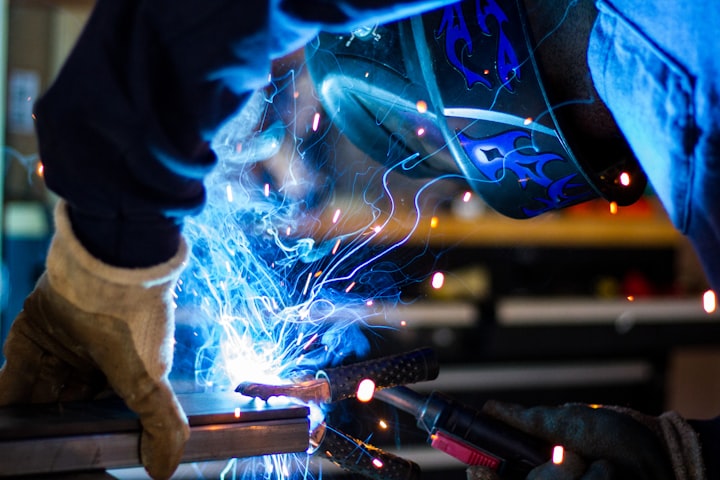

Comments
There are no comments for this story
Be the first to respond and start the conversation.